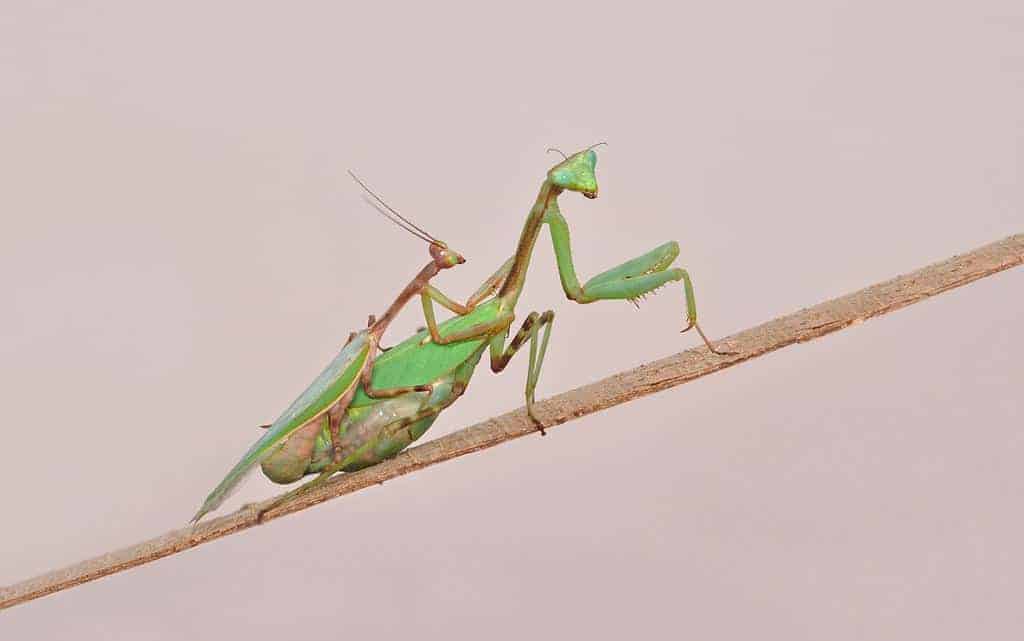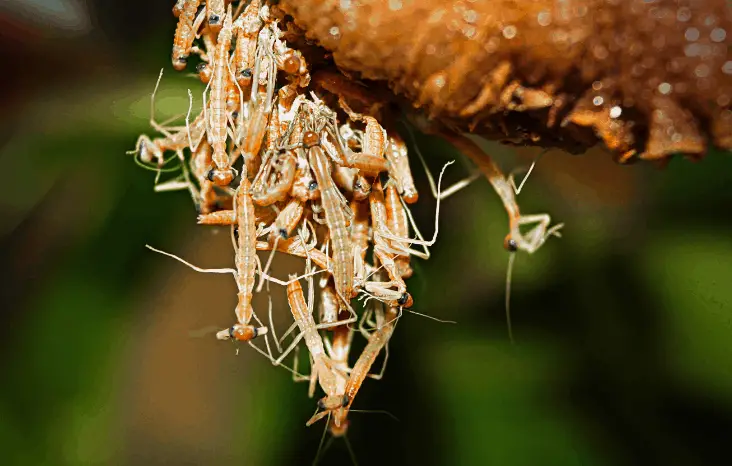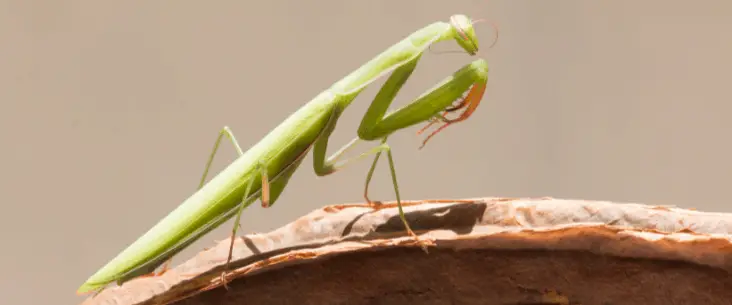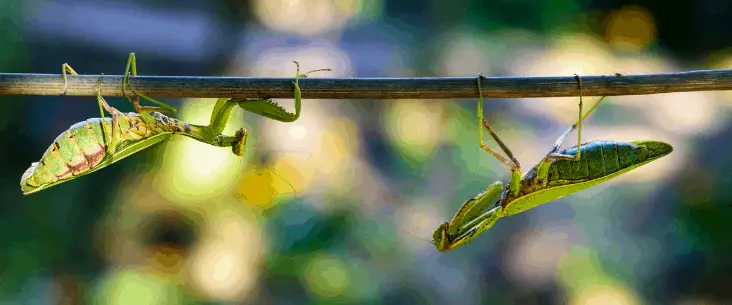Have you ever seen praying mantises group together? Probably not. Not strange, because these insects are solitary animals. This means they live on their own without the company of conspecifics. Praying mantises don’t even care for their young. They glue the eggs — called ootheca — on a branch and will carry on with their life. But when you keep praying mantises as a pet, can you keep two or more praying mantis together in one enclosure? This article explains if it is possible to house praying mantis together.
Praying mantises are solitary animals that don’t like the company of others and therefore generally can’t be housed with two or more of the same or other species. A praying mantis is highly predatory and will cannibalize any conspecific close by. However, a few species will tolerate conspecifics and can be housed together.
Although it is not generally advised to keep praying mantis together, there are conditions in which you can house praying mantis in a communal setup.
Can you keep 2 or more praying mantis together?
A praying mantis is not only carnivorous but a vast majority is also cannibalistic — meaning they will eat others (even of the same species) when they have the chance. So the general advice is to keep praying mantis solitary. They enjoy being on their own and most species don’t tolerate any competition.
If you just want to enjoy this beautiful and interesting species then I highly recommend taking only one and keeping it alone in the enclosure. Fancy a second specimen/species? Then you should keep it in another enclosure.
Praying mantis are famous for their cannibalistic behaviour and will literally fight until death when they come across any possible competition. When you keep two (or more) praying mantis in one enclosure will — sooner or later — almost always end in tears and one praying mantis that you don’t have to feed for a while.
But what about those anecdotal stories of keeping praying mantis together. Well, there are some praying mantis species that can be kept in small groups. They still live a solitary life but can under certain conditions tolerate other conspecifics in close proximity. Keep on reading about those praying mantis species.
Some other insect species that can be housed together just fine
Most insects are solitary which means that they don’t need social interactions or don’t need the benefits living a group. They are not depended living in a group. That doesn’t mean that all insects can’t be housed in (small) groups together.
Fancy a insect species that can be housed in groups and tolerate each other? Then you should take a look at stick insects or millipedes. These two amazing species can be housed in groups or even with some (completely) other species. Want to know which insects can be kept together? Check out our mix-and-match cheatsheet!

Can you keep male and female mantis together?
But what about keeping a male and a female praying mantis together? Would that be an option? Well, I have to disappoint you, but most praying mantis species won’t even accept a buddy from the other sex. In fact, the praying mantis is most famous for its sexual cannibalism. That means that after mating the female will eat the male. I’ve written an article explaining more about sexual cannibalism.
So, with praying mantises that are solitary and can’t be housed with others, keeping males and females together also end in one praying mantis — probably the female.
Now, you may wonder how they do with breeding. Do you need to sacrifice a male every time you wish to breed with them? Luckily the answer is no. Although most keepers will advise that you need to be really careful. To help you out I’ve written a practical guide on how you can breed with praying mantises.
Why do praying mantises eat each other? Cannibalism explained in a nutshell
Cannibalism is defined as the act of consuming another individual of the same species. Although it is the ultimate taboo for humans, in nature it is a widespread phenomenon. And while there are still some questions unanswered, there are multiple benefits using this strategy. When food is constrained your conspecifics may be the perfect food source. It also lower population density, competition and stimulates the survival of the fittest (so with the stronger genes). Now there is a lot the learn about cannibalism. I like to recommend you to read this article from Nation Geographic about cannibalism.
Can you keep baby praying mantis together?
But what about baby praying mantises? You might think that cannibalism only occurs with adult specimens. Nothing is further from the truth. Even smaller baby praying mantis will eat each other when they have the chance to reduce competition.
However, they will do that — and it differs from species to species — from the third or fourth developing stage. So, when praying mantises are just hatched they will tolerate each other. Well, at least when there is enough food provided. In the wild, baby praying mantises will immediately disperse in the bushes, probably never see each other again.
Generally speaking, when species tolerate each other when they are adults, they will tolerate each other when they are young. If you provide enough space, hiding spots and food, it won’t be a problem.
Now let’s talk about the species that will tolerate each other as we mention every time. What praying mantis species can be housed together?

Which praying mantis species can be kept together?
As we mentioned before there are a few species that — even when solitary and independent — will tolerate each other and can be housed in groups. Although we keepers don’t know it for every species out there, some creative keepers have experimented and have found these species that can be housed in groups.
An important note to start with — although we talk about communal species, there are still cases where sometimes an individual will eat another individual under certain circumstances. If you are a beginner it is best to start keeping every praying mantis solitary, even for species that can be housed in groups it is perfectly fine. It can occur that you have an aggressive individual that won’t fit in a communal setup, even with the label of “suitable for group housing”.
- Ghost mantis (Phyllocrania paradoxa)
- Wandering violin mantis (Gongylus gongylodes)
- Devil’s flower mantis (Idolomantis diabolica)
- Arizona unicorn mantis (Pseudovates arizonae)
- Moss mantis (Haania orlovi)
- African giant stick mantis (Heterochaeta orientalis)
- Egyptian mantis (Miomantis paykullii)
The list of species above is known to be kept together quite well. One of the most popular praying mantis that is housed in groups is the Ghost Mantis. These are smaller and beautifully shaped, but when you are more experienced the other species can also be housed in small groups, at least when you keep them in the right conditions. So let’s talk about that.
How do you keep praying mantis together?
So we now know that a few praying mantis species are suitable to house two or more together. But there is a strong caveat: If the conditions are not right there is a higher chance that even these species will eat each other. So, how can you succeed in keeping these species together then?
- As mentioned in the previous section, choose a species that is suitable to keep in groups. Only a few species are suitable, where the Ghost Mantis being the most popular one. With any other species, there is a high risk that they will eat each other.
- Provide enough space so each individual can hide from others if they wish. If they are continuously in close proximity to each other causes a lot of stress and won’t result in happy and healthy praying mantises.
- Provide enough shelter and hiding places so there are visual barriers. Each individual needs the space to separate from the others if they like to. You can use branches and plastic foliage to create enough barriers and hiding places for them.
- Offer enough perches for them to sit/hang on. It also has to do with space, but a large enclosure with only a few perches won’t do much. This is especially important when they are ready to moult. During moult, a praying mantis is very vulnerable and unable to defend itself. Moulting is also a stressful time and they need a quiet place to crawl out of their old skin.
- It is best to keep similar-sized specimens together. When there is a lot of variation (so babies together with adults) you have a higher risk that the adults will eat the smaller ones. That’s why you’ll need to hatch and raise baby praying mantises in a separate enclosure. You can find more about that and other practical tips in our breeding guide for praying mantises.
- Feed them well. That doesn’t mean you should let them overeat themselves, but when praying mantises are hungry they will hunt each other as a survival mechanism. It is therefore important to make sure every mantis will eat when you provide food. Try to offer them insects from a small tweezer if you can, to make sure every mantis has had enough food. Keeping them well-fed will not exclude but surely limit the risk that one eats the other.
Can you keep praying mantises with other species?
But how about keeping praying mantises with other species in one enclosure? With praying mantis it is best to keep them without any company of other species. Because praying mantises are fierce hunters, other insect species often end up as a meal.
However, there are some species that can be housed together with other species. The easiest example is the ghost mantis and wandering violin mantis. These species live higher up in the enclosure and almost never come down. They also feast mainly on flies (and the babies on fruit flies). So you can mix them with ground-dwelling and burrowing insect species like some species of beetles or millipedes. However, make sure these species live only on the ground and are adjusted to the same climate as the praying mantis species. For example, wandering violin mantises like it dry and hot. Many beetles and millipedes — and many other insects for that matter — like it moist and need a thick layer of a substrate. So you’ll need to do a lot of research and be more experienced before starting communal setups with praying mantis species. And even then it is no guarantee it will be a success.
Much more to learn!
There is much more to learn about praying mantises. For example, how to tell if the praying mantis is a male or a female? You can find more articles about praying mantises with plenty of practical tips to better understand and enjoy the keeping of these wonderful species as a pet.
Share this page!



